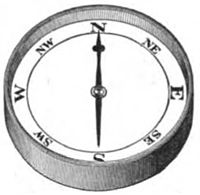If we should meet a boy walking in the opposite way, he would be going toward the south.
The sun, we see, helps us to learn the principal directions, north, south, east and west. These are what we call fixed points.
If the place to which we are going lies half-way between the north and east, its direction is northeast. If it is half-way between north and west, the direction is northwest. If the place is half-way between south and east, the direction is southeast. And if it is half-way between south and west, the direction is southwest.
From what we have now learned we see that when the sun shines it is easy to tell in what direction we are going. But there is something that shows direction even better than the sun.
Sometimes people are days and days at sea without seeing the land, and with nothing but sky above them and water all around. Often the sky is covered with clouds, and the sun cannot be seen. How do they know which way to go? They use what is called the compass. In it there is a little needle made of steel that always points toward the north.
With a compass, therefore, we can always tell which way is north. And if we know where north is, we can also tell where the south, the east and the west are.
The Indians and hunters who catch animals for their fur live a great deal in the forests. Often there are no roads to guide them. Sometimes it is very cloudy, and they cannot see the sun. They are said to have a very curious way of finding out where the north is.
Moss grows best in shady places, and generally grows thickest on the north side of the trunks of trees, because the sun does not shine much on that side.
The hunters and Indians, therefore, look to see which side of the tree is covered with moss. They know that the mossy side is the north side. Moss is to them as good a friend as the compass is to the sailor.
At night it is easy to find one's way if the stars can be seen. There is one star which is always in the north. We can see it in the picture.
The single star is called the North Star because it is always in the north. We find it by the help of two bright stars in the Great Dipper. They are called the Pointers.
For Recitation.—What do you mean by direction? What are the chief directions? How can you tell where the east is? Where is the west? Where is the north? Where is the south? What other points of direction are often spoken of? What shows direction better than anything else?
LESSON III.
DISTANCE.
Preparatory Oral Work.—Have pupils, using twelve-inch rulers, draw lines on the board one foot long; two feet long; one yard long, etc. Draw in various directions lines of different lengths, and ask how long each is. Test the correctness of answers with the ruler. Have children draw lines by guess, and test the accuracy of their guesses.
Have the pupils learn what two places in the neighborhood are about one mile apart; in a city, how many blocks there are to a mile. Have pupils tell about their walks or drives, noting distance and time.
1. What we Mean by Distance.—It is not easy to find a place if we know only in what direction it is from us. We should know also how far away it is, or the distance we shall have to go before reaching it.
If we know only that the house of a friend is east of ours, we cannot tell just where it is. But if we know that it is east of ours, and also how far east, then we can tell very nearly where it is.
The honey-bee knows exactly in what direction it must fly when it wishes to go home, and it knows also the distance, or just how far it must fly.
The mother bird that has her little ones in a nest in the tree, knows not only in what direction she must fly, but how far she must fly, so as to get back to the nest.
The bees and birds all know direction and distance by instinct. We have to learn.
We have already seen how we learn about


